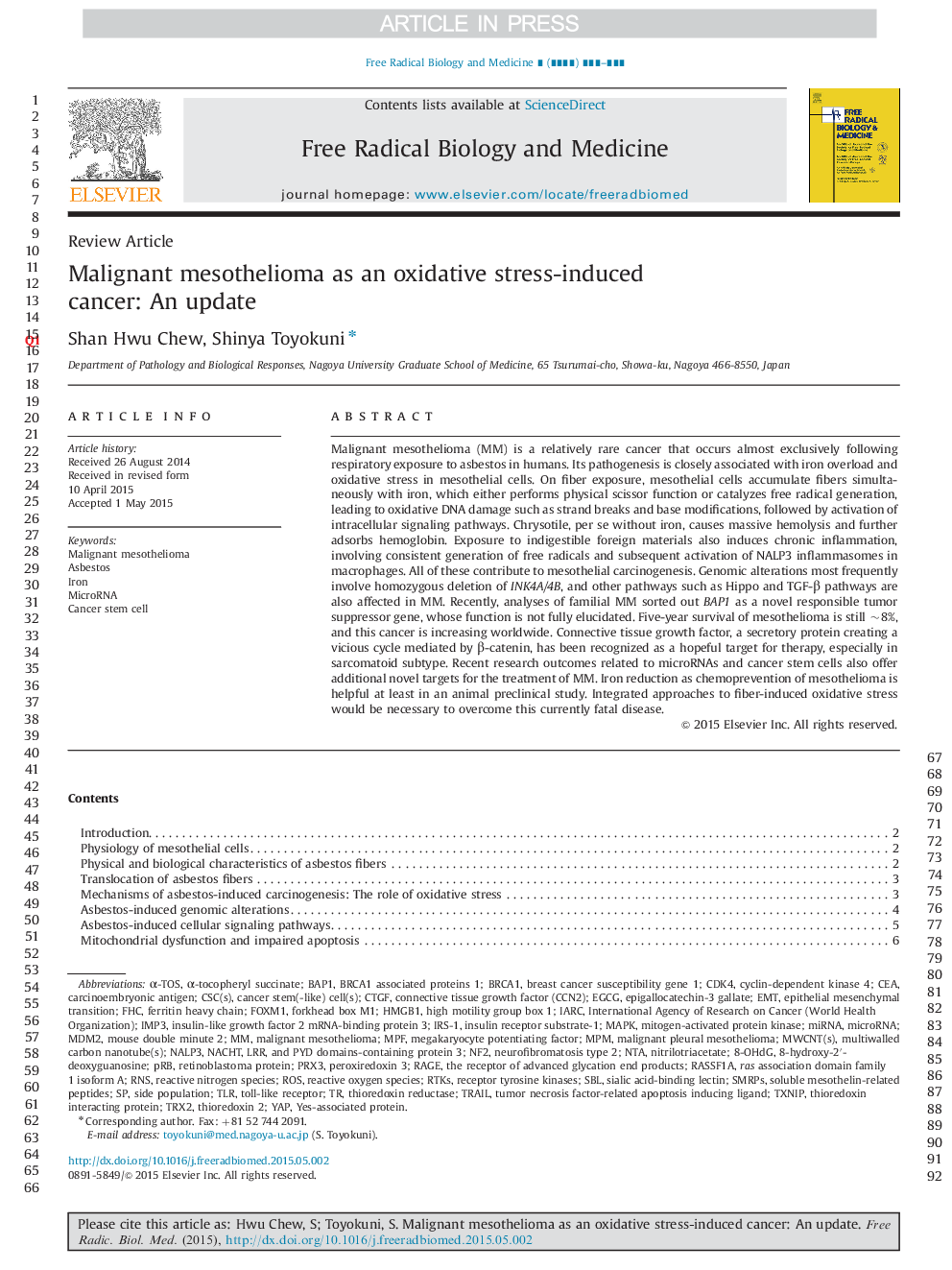| Article ID | Journal | Published Year | Pages | File Type |
|---|---|---|---|---|
| 8268890 | Free Radical Biology and Medicine | 2015 | 13 Pages |
Abstract
Malignant mesothelioma (MM) is a relatively rare cancer that occurs almost exclusively following respiratory exposure to asbestos in humans. Its pathogenesis is closely associated with iron overload and oxidative stress in mesothelial cells. On fiber exposure, mesothelial cells accumulate fibers simultaneously with iron, which either performs physical scissor function or catalyzes free radical generation, leading to oxidative DNA damage such as strand breaks and base modifications, followed by activation of intracellular signaling pathways. Chrysotile, per se without iron, causes massive hemolysis and further adsorbs hemoglobin. Exposure to indigestible foreign materials also induces chronic inflammation, involving consistent generation of free radicals and subsequent activation of NALP3 inflammasomes in macrophages. All of these contribute to mesothelial carcinogenesis. Genomic alterations most frequently involve homozygous deletion of INK4A/4B, and other pathways such as Hippo and TGF-β pathways are also affected in MM. Recently, analyses of familial MM sorted out BAP1 as a novel responsible tumor suppressor gene, whose function is not fully elucidated. Five-year survival of mesothelioma is still ~8%, and this cancer is increasing worldwide. Connective tissue growth factor, a secretory protein creating a vicious cycle mediated by β-catenin, has been recognized as a hopeful target for therapy, especially in sarcomatoid subtype. Recent research outcomes related to microRNAs and cancer stem cells also offer additional novel targets for the treatment of MM. Iron reduction as chemoprevention of mesothelioma is helpful at least in an animal preclinical study. Integrated approaches to fiber-induced oxidative stress would be necessary to overcome this currently fatal disease.
Keywords
FHCRAGEIRS-1HMGB1TLRTRX2IMP3NF2MPMPRBBAP1RNS8-OHdGMPFCTGFNALP3α-TOSPrx3Ras association domain family 1 isoform ATXNIPSBLNTAEGCGRASSF1ACDK4FOXM18-hydroxy-2′-deoxyguanosineCeAMAPKMdm2ROSRTKsα-tocopheryl succinatecarcinoembryonic antigenIronIARC یا International Agency for Research on Cancerepithelial mesenchymal transitioninsulin receptor substrate-1YAPthioredoxin reductaseThioredoxin 2EMTToll-like receptorforkhead box M1Side populationFerritin Heavy Chaincancer stem cellMegakaryocyte potentiating factorTRAILtumor necrosis factor-related apoptosis inducing ligandMouse double minute 2Malignant mesotheliomaMalignant pleural mesotheliomaMicroRNAMiRNAneurofibromatosis type 2Nitrilotriacetateperoxiredoxin 3retinoblastoma proteinThioredoxin interacting proteinmitogen-activated protein kinaseAsbestosBRCA1breast cancer susceptibility gene 1cyclin-dependent kinase 4reactive nitrogen speciesReactive oxygen speciesreceptor tyrosine kinases
Related Topics
Life Sciences
Biochemistry, Genetics and Molecular Biology
Ageing
Authors
Shan Hwu Chew, Shinya Toyokuni,
